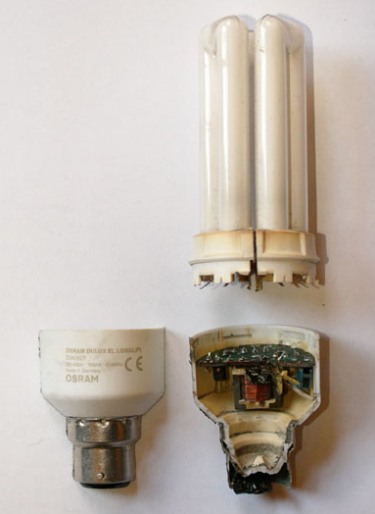What we are throwing away. . .
This is an Osram CFL from a few years ago that has stopped working. I cut the base in half with an angle grinder as a hacksaw would not cut the black insulating material in the bayonet connector. This rather brutal approach destroyed quite a few components on the board. This is basically a pretty crude electronic fluorescent gear that is not nearly as efficient as it could be as evidenced by the rather large choke, the thing that looks like a transformer with an iron core and copper windings at the back. This lamp (when it was working!) started with a brief flicker. One of the broken bits was a neon lamp as are found in old fashioned starters so I suspect this was part of a crude and inefficient capacitor start, these are also likely to fail before other parts of the lamp.
The weight of this lamp was 82 grammes, 20 grammes was the circuit board that may well have been working and certainly is in many lamps that are thrown away. The glass tube is 40 grammes, the metal lamp cap 6 grammes therefore 16 grammes of plastics derived from fossil fuels makes the remainder. The mercury content will be anything between 2mg and 5mg depending on the age and manufacturer of the lamp.
The construction of this lamp allows the electronics module to be easily separated from the tube however the plastic base is fixed to the tube with expanded foam so it would be difficult to separate the plastic and glass for recycling.
A typical equivalent Incandescent lamp weighs 34 grammes approximately 27 grammes of this being the glass envelope, cap approximately 6 grammes and approximately 1 gramme of metals including the filament.
Since writing this page some further information has come to my attention. As part of the EuP work done by VITO, spreadsheets were used to analyse the environmental impact of different lamp types. The spreadsheets were originally written for the assessment of the impact of general domestic electrical equipment so there may be errors due to the relative size of lamps. The outputs of the spreadsheet included the following numbers:
• Energy used in manufacture:
GLS 1 MJ = 0.28KwH CFLi 12MJ = 3.33 KwH
• Pollutants created in manufacture and winning the materials required:
GLS 5 grammes, non hazardous CFLi 128 grammes, 78 grammes being hazardous waste
So basically each CFLi manufactured causes one and a half times its weight in waste and a weight equal to itself in hazardous waste. As I said above these figures are subject to question but are alarming as they stand.

